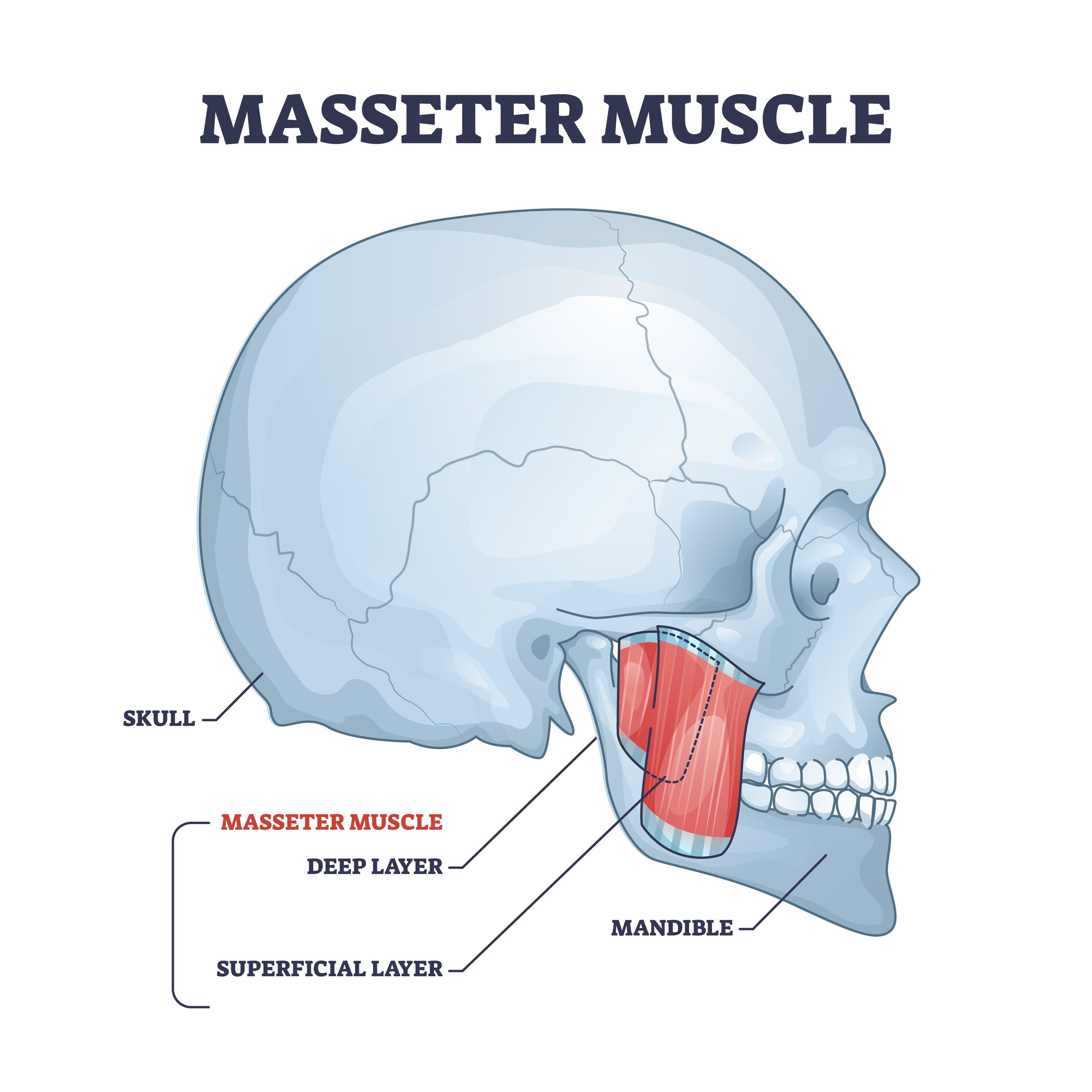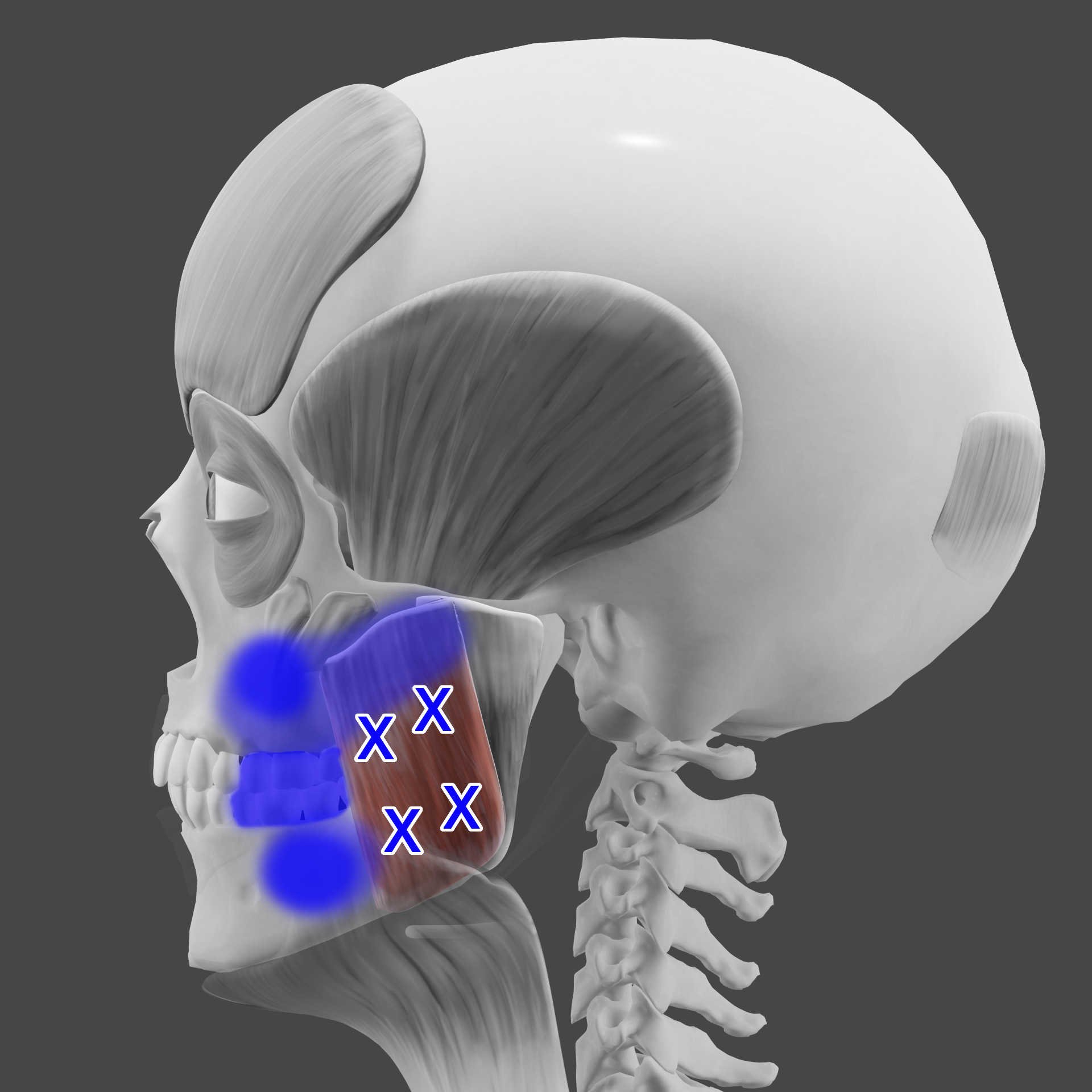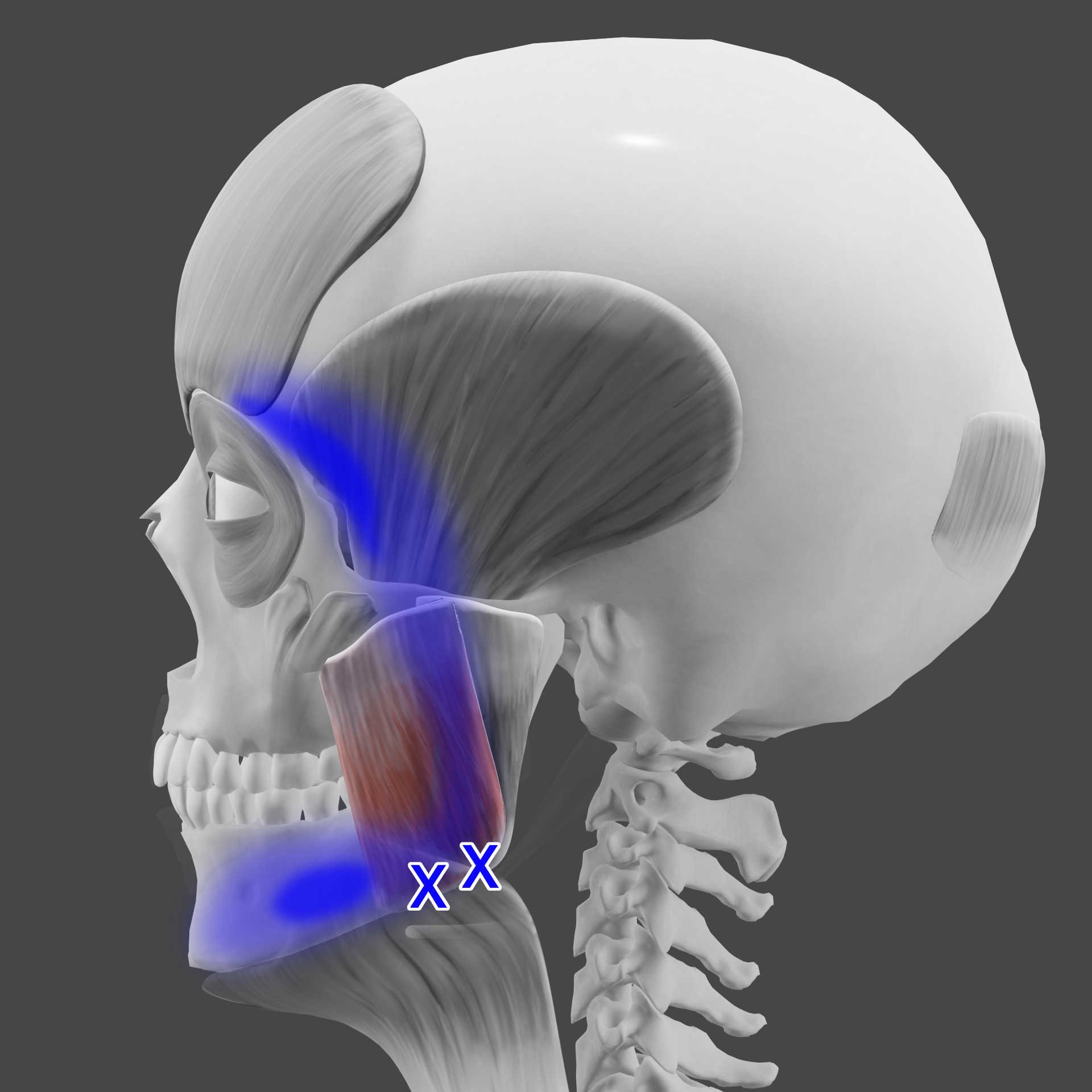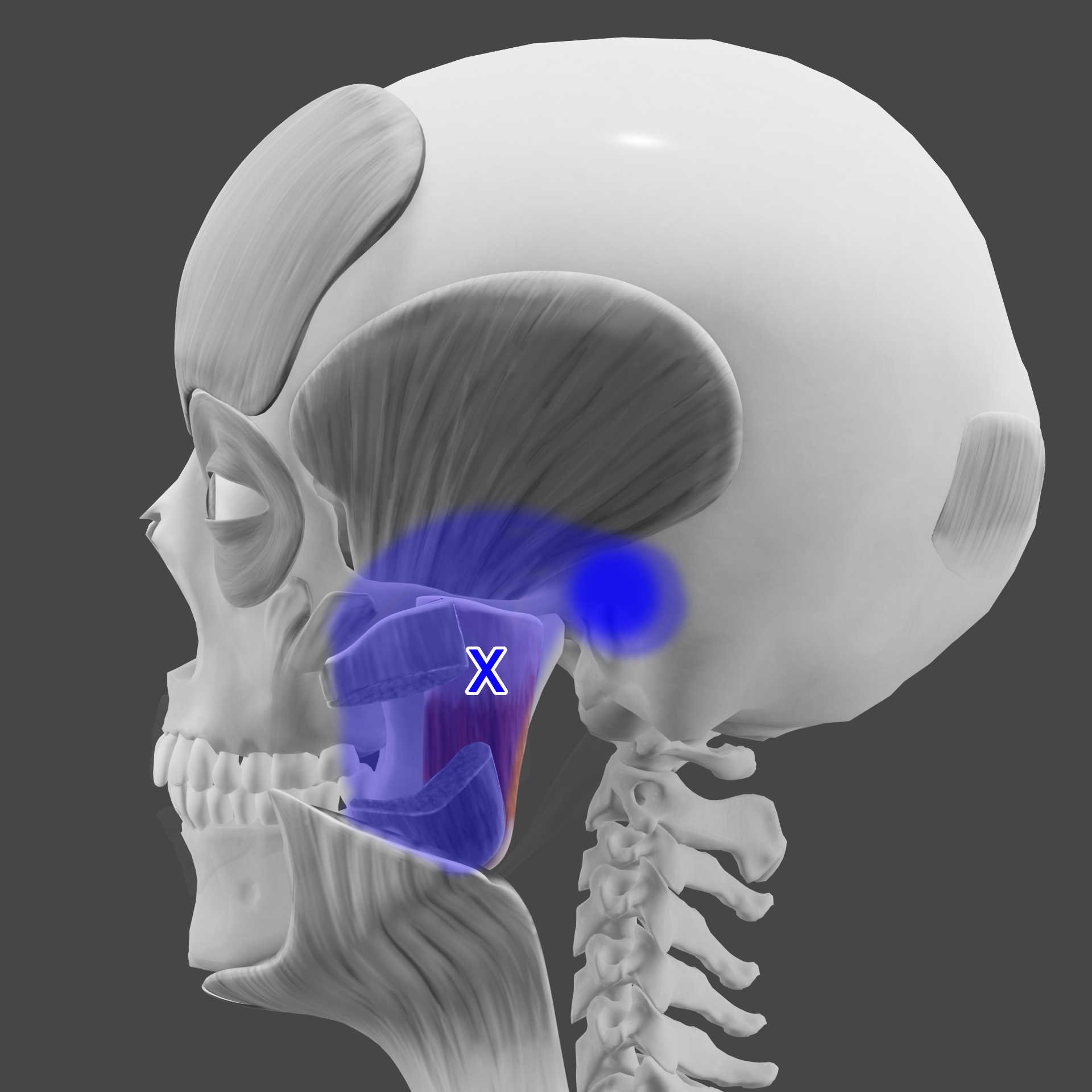Masseter Trigger Points
Do you experience discomfort or pain in the face or jaw area? The masseter, a muscle located between the jaw and cheekbone, could be involved. This blog post explores the masseter, its common trigger points, and how acupuncture and dry needling might be effective treatments for pain relief and improved muscle function.
What is the masseter muscle?
The masseter muscle is a key muscle for jaw movement.
Located in the jaw, responsible for elevating the mandible for chewing.
Can be the cause of restricted jaw opening when dysfunctional.
The masseter is one of the four muscles of mastication - a list that includes the masseter, temporalis, medial pterygoid, and lateral pterygoid. These muscle work to open and close the mouth by their effects on the jaw (mandible). The masseter and temporalis make up the superficial portion of these muscles, while the medial and lateral pterygoid muscles (along with the deep portion of the masseter) make sure the deep portion.
The masseter muscle plays a crucial role in our ability to chew and speak. It is one of the muscles that power the jaw by lifting the mandible, the lower jawbone, which helps to close our mouth. When it becomes dysfunctional, often due to trigger points (TrPs), it can cause a severely restricted jaw opening and significant pain, affecting daily activities like eating and conversation.
Masseter muscle
Masseter Functions
Elevate the mandible
Assist to protract mandible
The masseter connects from the cheek bone to the lower jaw - so it’s actions involve lifting the jaw and moving it.
Masseter Origin and Insertion
The masseter origin is from the zygomatic arch.
The masseter insertion is on the angle and ramus of the mandible.
This muscle's origin and insertion points allow it to exert powerful leverage on the jaw, highlighting its importance in dental and facial health.
Masseter Synergists and Antagonists
Synergists include the temporalis and medial pterygoid muscles in elevating the jaw as well as the pterygoid muscles in protracting the jaw.
Antagonists involve muscles that open the jaw, such as the digastric and hyoid muscles (geniohyoid, mylohyoid, stylohyoid) and also muscles the retract the jaw like the temporalis and digastric muscles.
A balance between the masseter and its synergists and antagonists is crucial for a harmonious function of the jaw, any imbalance can lead to pain and dysfunction.
Masseter Trigger Points
Masseter Trigger Points
Summary
Trigger points in the masseter increase muscle tension and pain.
Activation can be from acute overload or chronic muscle stress.
Perpetuation of trigger points often results from chronic habits or stressors.
Trigger points in the masseter muscle are hyperirritable spots that can cause pain and jaw dysfunction, often requiring targeted treatment like acupuncture or dry needling. The masseter muscle, comprised of both superficial and deep layers, is a common site for myofascial trigger points that can cause a wide range of referred pain sensations.
Superficial Layer: Trigger points in the superficial layer of the masseter predominantly refer pain to the lower jaw, molar teeth, and associated gums, extending up to the maxilla. When these TrPs are situated near the anterior border and superior part of this layer, the pain can radiate to the upper premolar and molar teeth and adjacent gums, often misleadingly described by patients as "sinusitis." Pain from TrPs located below the muscle's midbelly typically manifests in the lower molar teeth and mandible. Furthermore, TrPs near the lower edge of the mandible can project pain in an arc across the temple to the eyebrow and also to the lower jaw. This pain can even affect the area preauricularly near the temporomandibular joint, potentially leading to enthesopathy at the gonial angle of the jaw.
Deep Layer: In the deep layer of the masseter, over the ramus of the mandible, TrPs can diffuse pain to the midcheek area, affecting regions near the lateral pterygoid muscle and the temporomandibular joint (TMJ). A particularly critical trigger point near the posterior zygomatic attachment of this deep muscle segment can refer pain deep into the ear and even induce ipsilateral tinnitus. This tinnitus, often experienced as a persistent "low roaring," can be activated or interrupted by specific jaw movements such as wide stretching. Unlike tinnitus from vestibular or central neurological lesions, it does not accompany deafness or vertigo.
These intricate referral patterns underscore the complexity of diagnosing and treating TrPs in the masseter muscle, illustrating how symptoms can often mimic or overlap with other conditions, such as sinusitis or ear disorders. Addressing these TrPs effectively requires a detailed understanding of their locations and associated referral patterns.
Indications for Masseter Trigger Points
Cheek Pain (like Sinusitis)
Ear Pain
Earaches/Tinnitus (Ringing)/Itch
Teeth Grinding (Bruxism)
Temporomandibular Joint (TMJ) Pain
Temporomandibular Joint Disorders (TMJ)
Upper and Lower Molar Tooth Pain (Toothache)
Temple and Eyebrow Pain
Masseter trigger points have a wide range of indications that all involve areas of the face or hear. Masseter pain can mimic other common facial pains, making this muscle a frequent but often overlooked culprit behind various types of orofacial discomfort.
Signs and Symptoms of Masseter Pain
Pain in TMJ
Impaired or restricted jaw opening
Ear pain
One sided tinnitus
The pain from masseter trigger points can be diverse, sometimes presenting as a deep earache or sensitivity in the teeth, contributing to misdiagnosis. Tinnitus (one-sided) may also be caused by this muscle.
Cause of Masseter Trigger Points
Grinding teeth or clenching
Nail biting
Chewing gum
Direct trauma
Dental procedures with mouth open for a long time
Chronic mouth breathing
Emotional stress and tension
While teeth grinding, or bruxism, is a common cause of masseter pain, there are also other causes like having long dental procedures, emotional stress, and postural issues.
Masseter Trigger Point Locations
Located in the superficial and deep layers of the muscle.
The superficial trigger points can have multiple locations in the muscle.
The deep trigger point is located closer to the ear and the deep portion of the masseter has a more vertical fiber direction.
Masseter Referral Pattern
Superficial TrPs: Refer pain to upper and lower teeth (can become sensitive to pressure and temperature change), maxilla, anterior mandible, eyebrow
Deep TrPs: Refer pain deep in TMJ and ear
The masseter muscle's referral patterns can be misleading, often mimicking other dental or facial issues, which is why professional diagnosis and treatment are vital.
Associated Trigger Points
Temporalis
Medial pterygoid
Lateral pterygoid
Sternocleidomastoid
Upper trapezius
The masseter doesn't work in isolation; other muscles participate and can develop their own trigger points that contribute to masseter pain, requiring a broader approach to treatment.
Differential Diagnosis
Toothache
Tension type headache
Earache
Tinnitus
Pupitis
Periodontal inflammation
A thorough examination is necessary to distinguish masseter pain from other conditions, ensuring an accurate diagnosis for effective treatment.
Acupuncture for Masseter Pain
Involves the insertion of needles at specific points to that may be local or distal to the side of pain.
May also targets both superficial and deep fibers for comprehensive treatment.
Often combined with advice on posture, habits, and stress management.
Acupuncture offers a non-invasive approach to treating masseter pain, working to restore balance in the muscle's function and reduce pain.
One study evaluated the short-term pain relief effects of acupuncture on chronic myofascial pain using an 11-point numeric rating scale, visual analog scale (VAS), and mechanical pressure assessments on the masseter muscle. A single-blind, randomized, controlled trial involving 15 subjects showed a significant increase in pain tolerance and notable reductions in face pain, neck pain, and headache among those who received real acupuncture compared to sham acupuncture, where a blunted needle was used. This suggests that real acupuncture effectively enhances pain tolerance and reduces pain in individuals with chronic myofascial pain.
Dry Needling for Masseter Trigger Points
Utilizes acupuncture needles to directly target and deactivate myofascial trigger points.
Can provide rapid relief from muscle tension and referred pain.
Performed by trained practitioners for safe and effective results.
Dry needling for masseter trigger points focuses specifically on eliminating the hyperirritable spots within the muscle, often yielding quick and noticeable improvements in symptoms.
One study investigated the impact of dry needling on active trigger points in the masseter muscle of patients with temporomandibular disorders (TMD). Twelve female patients underwent two treatment sessions where they received either deep dry needling or sham dry needling. Results indicated significant improvements in pressure pain threshold (PPT) and pain-free jaw opening in patients treated with real dry needling compared to those who received the sham treatment, demonstrating the efficacy of dry needling in enhancing pain tolerance and functional outcomes in myofascial TMD patients.
Frequently Asked Questions about Masseter Trigger Points
How do you release a masseter trigger point?
To release a masseter trigger point, targeted treatments such as acupuncture or dry needling are effective. Acupuncture and dry needling involve inserting needles at specific points around the masseter to relieve pain and reduce muscle tension.
Can you get knots in your masseter muscle?
Yes, knots, or myofascial trigger points, can develop in the masseter muscle due to stress, overuse, or injury. These knots can cause pain and restrict jaw movement.
What are the symptoms of a tight masseter?
Symptoms of a tight masseter include jaw pain, difficulty opening the mouth fully, and discomfort when chewing or speaking. Sometimes, a tight masseter can also lead to headaches and ear pain.
Where are trigger points in the jaw?
Trigger points in the jaw are commonly found in the masseter muscle, which may refer pain to the teeth, cheek, ear, and TMJ area. These points can be palpated as tender spots on the muscle.
How do you relax a tight masseter?
To relax a tight masseter, treatments like acupuncture, dry needling, massage, and applying heat can be beneficial. Additionally, managing stress and avoiding excessive chewing or teeth grinding can help.
What is the fastest way to release trigger points in the masseter?
The fastest way to release trigger points in the masseter is through acupuncture and dry needling, where a needle is directly inserted into the knot to alleviate tension and pain quickly. These modalities can also offer rapid relief by targeting specific points to reduce muscle tightness and inflammation in related areas.
Over to you
If you liked this article, please share with friends and family who may be suffering with TMJ or masseter trigger points.
Sources:
Travell, J. G., Simons, D. G. (1993). Myofascial pain and dysfunction: The trigger point manual. London: Lippincott Williams & Wilkins.
Biel, A., & Dorn, R. (2010). Trail guide to the body: A hands-on guide to locating muscles, bones and more. Boulder, CO: Books of Dicovery.
Janda, Vladimír. “Muscle Function Testing.” (1983).
Corcoran NM, Goldman EM. Anatomy, Head and Neck, Masseter Muscle. [Updated 2023 Jun 5]. In: StatPearls [Internet]. Treasure Island (FL): StatPearls Publishing; 2024 Jan-. Available from: https://www.ncbi.nlm.nih.gov/books/NBK539869/
Shen, Y. F., & Goddard, G. (2007). The short-term effects of acupuncture on myofascial pain patients after clenching. Pain practice : the official journal of World Institute of Pain, 7(3), 256–264. https://doi.org/10.1111/j.1533-2500.2007.00140.x
Fernández-Carnero, J., La Touche, R., Ortega-Santiago, R., Galan-del-Rio, F., Pesquera, J., Ge, H. Y., & Fernández-de-Las-Peñas, C. (2010). Short-term effects of dry needling of active myofascial trigger points in the masseter muscle in patients with temporomandibular disorders. Journal of orofacial pain, 24(1), 106–112.
Mierzwa D, Olchowy C, Olchowy A, Nawrot-Hadzik I, Dąbrowski P, Chobotow S, Grzech-Leśniak K, Kubasiewicz-Ross P, Dominiak M. Botox Therapy for Hypertrophy of the Masseter Muscle Causes a Compensatory Increase of Stiffness of Other Muscles of Masticatory Apparatus. Life (Basel). 2022 Jun 6;12(6):840. doi: 10.3390/life12060840. PMID: 35743871; PMCID: PMC9225551.
Witmanowski H, Błochowiak K. The whole truth about botulinum toxin - a review. Postepy Dermatol Alergol. 2020 Dec;37(6):853-861. doi: 10.5114/ada.2019.82795. Epub 2019 Feb 5. PMID: 33603602; PMCID: PMC7874868.
Disclaimer: This web site is intended for educational and informational purposes only. Reading this website does not constitute providing medical advice or any professional services. This information should not be used for diagnosing or treating any health issue or disease. Those seeking medical advice should consult with a licensed physician. Seek the advice of a medical doctor or other qualified health professional for any medical condition. If you think you have a medical emergency, call 911 or go to the emergency room. No acupuncturist-patient relationship is created by reading this website or using the information. Morningside Acupuncture PLLC and its employees and contributors do not make any express or implied representations with respect to the information on this site or its use.






